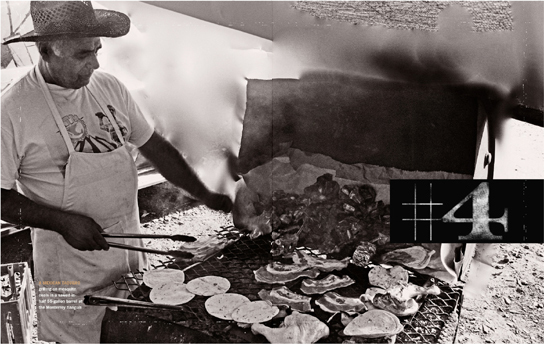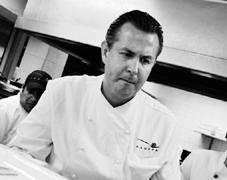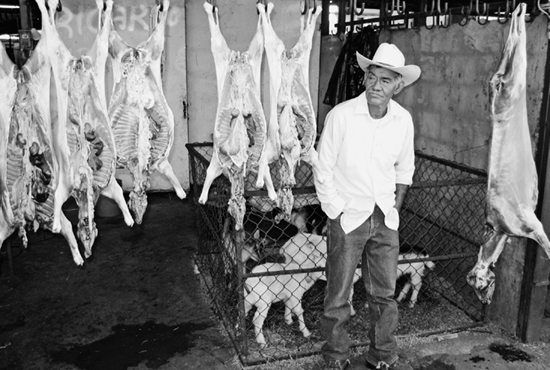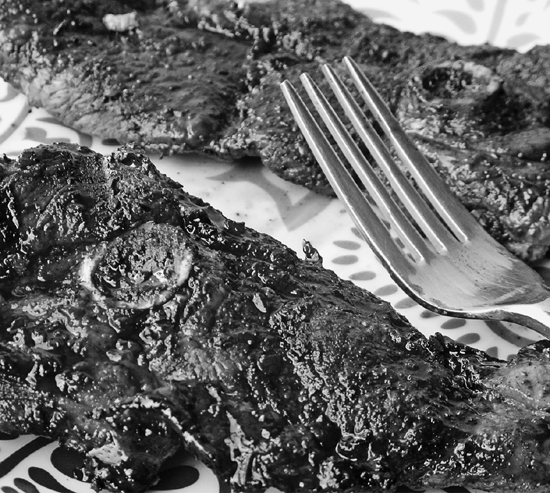
A Mexican taquero grilling on mesquite coals in a sawed-in-half 55-gallon barrel at the Monterrey tianguis
El Indio Azteca is a legendary Monterrey bar. It’s decorated with dark wood paneling and lots of deer heads. The taverna muy famosa recently celebrated its hundredth anniversary. • “What’s your specialty?” I asked the third-generation proprietor, Felipe González González, as I looked over the menu. • “We have only meat,” he replied. I had to chuckle at his response. “Regios,” as the people of Monterrey are called, are unabashed carnivores. They eat meat for breakfast, lunch, and dinner and they don’t see anything unusual about it. All that meat goes great with their other obsession: beer.
Monterrey is home to Cervecería Cuauhtémoc Moctezuma, Mexico’s largest brewery. They are the makers of such popular brands as Dos Equis, Tecate, and Bohemia and Mexican favorites Carta Blanca and Indio. When you go drinking in Monterrey, don’t make the mistake I did and ask for Negra Modelo; that brand, along with Corona, is made by Mexico’s second largest brewery, Grupo Modelo—a bitter rival based in Mexico City.
Beer is the beverage of choice at El Indio Azteca and in the old days, the botanas, or bar snacks, were free. With your first round, you got a small plate, and with your second you got something bigger. The more you drank, the better the botanas would get. Luckily, you don’t have to drink your way to the quality chow anymore; you just order whatever you like from the menu.
A side dish of roasted serrano chiles with lots of black char and lime wedges is set on the table with every dish. There’s a light coat of oil clinging to the serranos and they have been well salted. The roasting renders the peppers nearly heat-free. I ended up eating three with my first Bohemia. I made a mental note to start roasting chiles every time I heat up the grill.
My drinking companion, Guillermo González Beristáin, recommended the higado, or pig’s liver. Trained at the Culinary Institute of America, young, handsome, and six feet four inches tall, Guillermo is one of Mexico’s top chefs. I met him at a culinary event in San Antonio and he invited me to look him up if I was ever in Monterrey.
While I was working on this book, I visited La Catarina, one of Guillermo’s restaurants. He taught me a little about cooking cabrito. When Guillermo got off work, we stopped by El Indio Azteca for a couple of cold ones and a chat about meat.
“So why is it that people eat so much meat in Monterrey?” I asked Guillermo as we chowed down. The chef’s family came from Mexico City and he grew up in Ensenada, he explained, so he is not a local expert. But he does know a little about Mexico’s food history.
The sparse vegetation of the desert Norteño region supports livestock grazing, but very little agriculture. For most of its history, Monterrey had only five staples besides meat, Guillermo observed: nopales (“cactus paddles”), tomatoes, chiles, tortillas, and beans. But while meat was considered a luxury in the rest of Mexico, here in the ranching region, it was among the cheapest foods available. The explanation makes a lot of sense—on both sides of the border.
The ranching culture of Northern Mexico is a window on the origins of Tex-Mex. Much has been made lately of “eating local.” When you live in a cattle-raising center, eating local means eating meat.
Tequila, sangrita, and cold Superior beer at El Indio Azteca in Monterrey
One of the classiest meat markets in Monterrey is called Carnes Ramos, and it’s located in the upscale San Pedro Garza Garcia neighborhood. Above the counter, there are food porn shots of steaks and roasts. The gigantic store is gleaming white, well scrubbed, and tastefully decorated, with faux marble floors. I stood in the middle of the butcher shop with a friend polishing off a half pound of hot chicharrones. The meat displayed here is in huge primal cuts, but in the end, people take it home in little plastic packages, just like we do in the United States.
One Friday night, Guillermo invited me to his home for an elegant dinner party. He and his gorgeous wife, Karina, live on the top of a mountain overlooking the city near Chipinque National Park. The menu included cabrito en salsa, a braised goat dish (see this similar recipe), cabrito al pastor grilled over mesquite, and asado de puerco, a pork dish with ancho and orange zest). We also had a red wine from Baja California that was bottled exclusively for Guillermo’s restaurants.
Guillermo got his meat from restaurant suppliers, but he said that people who cooked cabrito at home in Monterrey prefer to buy their goats from local ranchers. Some drive out to the goat farms in the country, and some meet the ranchers at the tianguis—the local equivalent of a farmer’s market.

Chef Guillermo González Beristáin
The next morning, I grabbed a taxi and headed to the Saturday tianguis at Monterrey’s abandoned train station. Tianguis is a Nahuatl word that means an impromptu market. This tianguis was a wild bazaar of fruits, vegetables, live animals, and most of all, fresh carnes.
I figured it would be a good place to study Norteño grilling firsthand, and I was not disappointed. There were grills and flat tops set up everywhere. Each cook supervised an impromptu restaurant comprised of card tables and folding chairs surrounding the grill. Some were tiny affairs with a few customers and some were twenty-table operations.
The range in cooking equipment was staggering. A guy in a cowboy hat was grilling with mesquite wood on a fifty-five-gallon barrel “Texas hibachi” just like mine. This vaquero’s customers were eating steaks, chicken pieces, sausage, and several other grilled cuts. I was interested to see him heating tortillas the way a hamburger joint in the United States heats hamburger buns—by stacking them on top of the grilling meat.
Another man was slow-cooking a cabrito and a whole pig in a giant caja china, the kind of slow cooker that was made popular by food vendors along the beaches of Puerto Rico. (For more about the caja china, see here.) I also saw a few food stalls where the beans and nopalitos and other dishes were cooked over charcoal on an old-fashioned brazier.
But by far the most common cooking fuel was propane. The cooking surfaces were split evenly between flat tops and grates. I saw small girls flipping tortillas, formidable women caramelizing onions and peppers, and lots of people making tacos on flat tops. Meanwhile on the gas grills with grates, all manner of meat was being cooked along with corn on the cob, chile peppers, and other food that needed to char.
A few stalls were devoted to fresh vegetables. I saw lots of nopales cactus pads and found mounds of wild chile pequíns for sale. But more than half of the stalls were devoted to meat.
In a beef-draped stall, a seated butcher carved paper-thin round steak slices for milanesa from a huge hind leg of beef. He was surrounded by steaks, ribs, and skirts. A man walked by dragging a squealing live pig by the back leg, while at another stall, a guy in a cowboy hat stood frying chicharrones in beautiful copper vats. Freshly slaughtered kid goats hung from the awnings of several outdoor stalls. Passersby admired the pale, butter-colored flesh of the tiny carcasses, which were splayed open to show the kidneys still attached to ribs. Some of the dressed baby goats appeared to weigh less than six pounds.
Beneath the fresh meat display, a little chicken-wire pen held a dozen or so live kid goats. Regios like to develop a relationship with a rancher, my friend told me. Regular customers are invited to go visit the ranch and pay for their cabritos in advance and specify how they will be fed and at what age they will be killed. Then they meet the rancher at the market to inspect the animals and have them slaughtered on the spot.
It’s a very enlightened way to buy meat—once you come to terms with your decision to eat baby goats. The animals are very cute and it’s tough to remember that this isn’t a petting zoo. The connoisseur’s preference for ever smaller cabritos is easy to understand when the delicate milk-fed meat is on your plate. Here, you have to look the little fellows in the eyes, though. Like most Americans, I tend to think of baby animals as pets. The Saturday tianguis in Monterrey is a good place to get over that notion.
Monterrey is no little ranching town. It has become Mexico’s most advanced city, with more universities and computers per capita than anywhere else in the country. And yet the people of Monterrey have never lost touch with their Norteño livestock-raising heritage. I envy the Regios for that—and for their easygoing love affair with meat.

Cabrito stall at the Monterrey tianguis
4 rib-eye steaks, about 14 ounces each
4 teaspoons Tex-Mex Grill Blend
4 round slices of Chile Butter
STEAK GRADES
Kobe (left) is the highly marbled beef of Japanese Waygu cattle. These cattle are now being raised in the United States, but there is no American grading system available. The Japanese beef grading system has several levels above the equivalent of USDA Prime.
USDA Prime (middle) is the highest attainable American beef grade. While dry-aged USDA Prime was once the chef’s pick for the best quality steaks, Kobe cuts are now the most expensive in top steak houses.
USDA Choice (right) is a very broad category. Branded meat programs, such as Certified Angus, Certified Hereford, and Sterling Beef, cherry-pick the best cuts in the Choice category that meet their criteria to provide consumers with better steaks.

Mexican butcher cutting steaks at the Monterrey tianguis
BIG DEAL MEALS
If you grill for a crowd, eventually you’ll find yourself considering the merits of buying whole roasts and cutting them up. Working with larger cuts of meat is a little more work, but it’s a lot less expensive. You can buy a whole rib roast and cut your own rib-eye steaks for a fraction of what you’d pay for the steaks sold separately. And there are some wonderful cuts, like Tex-Mex Churrasco, that just aren’t available in the store. Here are a couple of recipes that require a little meat-cutting skill or some help from a butcher.
4 goat leg steaks (about 1 pound total)
1 tablespoon olive oil
4 teaspoons Tex-Mex Grill Blend
2 tablespoons butter
½ cup honey
1 habanero pepper

You can find leg-of-goat steaks at halal butcher shops
2 tablespoons olive oil
1 tablespoon fresh rosemary leaves
2 cloves garlic, chopped
Whole rack of lamb chops
2 teaspoons freshly squeezed lime juice
4 tablespoons pepper jelly
Sea salt
1 tablespoon freshly ground black pepper
5 tablespoons salt
1 cup white vinegar
6- to 8-pound cabrito on the bone
Olive oil
1 tablespoon sea salt
1 teaspoon freshly ground black pepper
Tex-Mex restaurant scion Victor Leál—with his grilled butterflied leg of lamb—in his backyard, overlooking the Palo Duro Canyon
Grilling steaks is elevated to an art form at the annual Texas Steak Cook-Off in Hico
Beef tenderloin, cleaned and peeled, about 4 pounds
1 cup fresh cilantro leaves
8 cloves garlic, minced
½ cup olive oil
½ cup freshly squeezed lime juice
1 tablespoon minced red onion
1 teaspoon freshly ground black pepper
½ teaspoon sea salt
½ teaspoon dried Mexican oregano
HOW TO CUT A WHOLE TENDERLOIN

The whole tenderloins you find at discount-store meat markets are generally around eight pounds before trimming.

To trim a whole tenderloin, cut off the chain meat along the bottom and the large chunk past the “thumb.” Use the large piece as a tenderloin roast, or cut both pieces into chunks and grill on skewers for kebabs.

Peel the silverskin off the remaining log-shaped tenderloin.

The peeled tenderloin should weigh around four pounds. This can be grilled whole, cut into filet mignon steaks, or double-butterflied and pounded for Tex-Mex Churrasco.